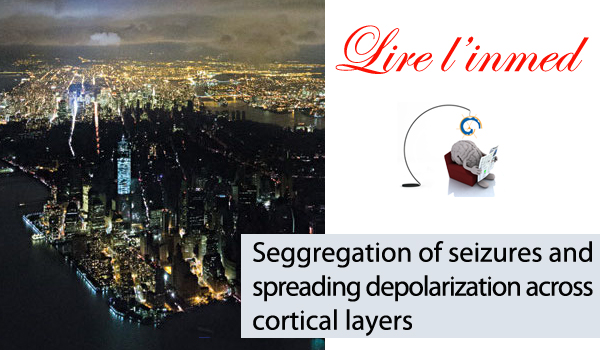Power out(r)age. Cortical spreading depolarization (SD) is a wave of collective neuronal depolarization known to occur during migraine, epilepsy and after brain injury. Neurons strongly depolarize and loose the ability to respond, which results in the shutdown of all types of electrical activity. SD and seizures collide in the epileptic brain. Here, the authors demonstrate this may occur along the vertical axis when SD wave stops at the border of deep layers of cortex leaving neurons fully epileptic there, while superficial layers are extinguished. (by Ingrid Bureau)
Authors: Andrey Zakharov, Kseniya Chernova, Gulshat Burkhanova, Gregory L. Holmes and Roustem Khazipov
Scientific abstract:
Objective: Cortical spreading depolarization (SD) and seizures are often co-occurring electrophysiological phenomena. However, the cross-layer dynamics of SD during seizures and the effect of SD on epileptic activity across cortical layers remain largely unknown.
Methods: We explored the spatial-temporal dynamics of SD and epileptic activity across layers of the rat barrel cortex using direct current silicone probe recordings during flurothyl-induced seizures.
Results: SD occurred in half of the flurothyl-evoked seizures. SD always started from the superficial layers and spread downward either through all cortical layers or stopping at the L4/L5 border. In cases without SD, seizures were characterized by synchronized population firing across all cortical layers throughout the entire seizure. However, when SD occurred, epileptic activity was transiently silenced in layers involved with SD but persisted in deeper layers. During partial SD, epileptiform activity persisted in deep layers throughout the entire seizure, with positive signals at the cortical surface reflecting passive sources of population spikes generated in deeper cortical layers. During full SD, the initial phase of SD propagation through the superficial layers was similar to partial SD, with suppression of activity at the superficial layers and segregation of seizures to deep layers. Further propagation of SD to deep layers resulted in a wave of transient suppression of epileptic activity through the entire cortical column. Thus, vertical propagation of SD through the cortical column creates dynamic network states during which epileptiform activity is restricted to layers without SD. Significance: Our results point to the importance of vertical SD spread in the SD related depression of epileptiform activity across cortical layers.

